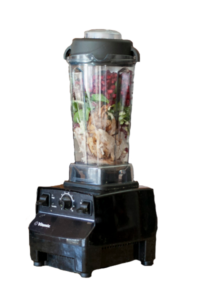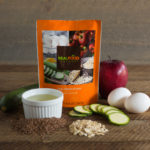Do You Really Need a Peptide Formula?

Do You Really Need a Peptide Formula?
The basics about peptides, when they should be used, and why to consider food first
by April Jackson, MS, RD, LDN, CNSC
Even with growing support for real food for people with feeding tubes, most people with feeding tubes are still put on standard (read: cheapest!) commercial formula when they first get a feeding tube. While these formulas can literally be lifesaving, GI-related intolerance symptoms are quite common. Several studies report the incidence of GI intolerance to be as high as 75%, especially in hospitalized patients.1 2 3 These intolerance symptoms include nausea, vomiting, diarrhea, constipation, retching, and reflux.
So what’s the standard treatment when a patient is having intolerance symptoms to a regular formula? The “old way” of treating side effects looks like this:
1. Prescribe medications to treat side effects. A recent review of hospitalized patients with feeding tubes noted that more than 37.9% of patients received a medication to stimulate stomach emptying and 13.4% of patients received more than one of these medications while on tube feedings.1
The need for these medications should really be examined, especially in situations where a patient hasn’t needed them as an oral eater, but now does when fed formula-only through the tube.
2. Next, switch to a lower rate of feeding (either via gravity or pump) to treat GI intolerance symptoms related to volume intolerance or dumping syndrome.
If a person is being fed one synthetic formula as their only nutrition, and that’s causing diarrhea 50% of the time, does it make sense to keep feeding that one formula as the only source of nutrition, just slower and over more hours? Imagine giving that advice to an oral eating person!
3. Another common approach for clinicians is to switch the patient from standard formula to a peptide-based formula to see if this is better tolerated. If a peptide formula isn’t tolerated, the patient is often moved to an elemental formula.
Is the form of protein really the problem? Comparing ingredient lists of a standard formula to a peptide formula, are they really THAT different?
What Exactly is a Peptide Formula?
 The difference between standard formulas and peptide (and elemental) formulas is all about how much the protein is broken down. Peptide-based formulas, also known as semi-elemental formulas, contain partially broken down (hydrolyzed) proteins, resulting in shorter chains of amino acids. These shorter chains mimic the process that occurs during digestion of proteins in the intestines. These formulas are recommended for those experiencing malabsorption, pancreatic dysfunction, or for prolonged bowel rest following major abdominal surgery or other evidence of gastrointestinal impairment.
The difference between standard formulas and peptide (and elemental) formulas is all about how much the protein is broken down. Peptide-based formulas, also known as semi-elemental formulas, contain partially broken down (hydrolyzed) proteins, resulting in shorter chains of amino acids. These shorter chains mimic the process that occurs during digestion of proteins in the intestines. These formulas are recommended for those experiencing malabsorption, pancreatic dysfunction, or for prolonged bowel rest following major abdominal surgery or other evidence of gastrointestinal impairment.
Elemental formulas, the next step in the typical enteral formula algorithm, contain proteins that are 100% broken down into amino acids. Amino acids are the building blocks of protein that are essential for growth and development. These formulas are considered hypoallergenic and are recommended for those with milk or soy protein allergies, food protein intolerances or allergies like Eosinophilic esophagitis, and severe malabsorption.
These specialized formulas were created for people who are unable to digest real food, or with severe allergies. If the patient has eaten regular food prior to the tube being placed, or the tube was placed due to the inability to safely eat orally, do they truly need a specialized formula?
What Does the Research Say About Peptides?
Limited research exists comparing the use of standard formulas to peptide formulas, and the data is conflicting in the research that is available. Because of this, the use of peptide and elemental formulas is based on expert opinion (Grade E).5 Some evidence suggests that peptide formulas may be helpful with very specific patients, such as those with malabsorption or pancreatic dysfunction or to allow prolonged bowel rest following major abdominal surgery or other evidence of GI disease.6 However, other studies have shown little to no difference in tolerance between standard and peptide formulas.5 6 7 8.
A recent study showed improved tolerance using peptide-based diets in patients at risk for significant malabsorption because of GI surgery or pancreatitis.9 Even with this study, however, 56 percent (30/53) of patients continued to experience nausea, vomiting, diarrhea, abdominal pain/cramping, gas/bloating, and abdominal distension on the peptide-based formula. There are no known studies that compare the use of peptide formulas to a real food diet (i.e. blenderized tube feedings.)
“Overall, little evidence appears to support the routine use of elemental or peptide formulas except in the presence of GI dysfunction such as malabsorption, pancreatic dysfunction, chyle leak, or other evidence of GI disease. Elemental or peptide formulas should be reserved for patients who failed a fair trial of standard formulas.”6
Peptides vs. Whole Foods
While research comparing peptide formulas to standard formulas is limited, there is a growing body of  evidence supporting the use of blenderized diets to help improve intolerance symptoms in both adults and children. Most notable are three studies that demonstrate improved outcomes on blenderized diets when compared to conventional formulas, including patients who were previously on peptide or elemental formulas:
evidence supporting the use of blenderized diets to help improve intolerance symptoms in both adults and children. Most notable are three studies that demonstrate improved outcomes on blenderized diets when compared to conventional formulas, including patients who were previously on peptide or elemental formulas:
Efficacy and Tolerance of Blended Diets in Children Receiving Gastrostomy Feeds
In this study from Johns Hopkins, researchers focused on the prevalence of GI symptoms in children receiving a blended diet via G tube and stated, “Typically one could expect medical providers to hesitate recommending whole food-based formulas to patients receiving elemental formulas because of anticipated intolerance.”4 However, all the children in this study successfully transitioned to a blended diet, including the 65% on peptide and amino acid-based formulas. The results showed:
- 95% of patients who switched to a blenderized diet experienced improvement in GI symptoms
- 53% of patients increased their oral intake
- 2 patients were able to switch exclusively to an oral diet after switching to a blenderized diet
The authors also point out that many patients were trialed on an amino acid-based formula because of GI intolerance symptoms like reflux or vomiting, even though test results were negative for milk protein allergies. This study demonstrates that GI intolerance to formula may be alleviated with the introduction of real food and that peptide based or amino acid-based formulas are not indicated for the treatment of common GI intolerance symptoms to standard formula.
Health Outcomes and Quality of Life Indices of Children Receiving Blenderized Feeds via Enteral Tube
This study from Boston Children’s Hospital looked at health outcomes, quality of life, and healthcare usage in patients receiving blenderized feeds compared to those on conventional formula.10 Patients in the blenderized diet group had greater overall satisfaction, less stomach pain, reflux, nausea, vomiting, diarrhea, and fewer total symptoms overall. In addition, the blenderized diet group was found to have a 43% reduction in emergency room visits, a 53% reduction in hospital admissions, and a 67% reduction in respiratory related admissions. In this study, 57% of patients on conventional formula were actually on elemental diets.
Blenderized enteral nutrition diet study: Feasibility, clinical, and microbiome outcomes of providing blenderized feeds through a gastric tube in a medically complex pediatric population
Researchers at The Hospital for Sick Children reported a decrease in vomiting, gagging, retching, and use of acid suppressing medications in a medically complex pediatric population when they switched to blenderized diets. A significant number of patients in this study were on peptide and elemental formulas as well as continuous pump feeds and yet the researchers considered these patients to be appropriate candidates for blenderized diets.
When considering if a patient is a candidate for a blenderized diet, it’s important to look at the reason the tube was originally placed, not just what formula they’re currently on. Does the patient have an underlying condition necessitating the peptide or elemental formula?
In addition, these studies show that patients receiving peptide and amino acid-based formulas tolerated intact protein and had less GI intolerance when switched to a blenderized tube feeding diet consisting of whole foods.4 11
Think Food First
 While peptide formulas can be helpful for certain patients, they are often prescribed to treat common formula intolerance symptoms, and research is mixed at best at whether peptides are actually successful in helping improve these symptoms. Real food options, whether a home blenderized diet or a commercial product like Real Food Blends, should be considered first in treating intolerance symptoms before moving onto more specialized formulas. So many Real Food Blends customers have let us know over the years how real food has helped improve intolerance symptoms, helping them reduce or eliminate medications, gain weight, and be healthier overall. Now research supports what we’ve been hearing for years — that many formula intolerance symptoms improve (or are eliminated) when real food is introduced.
While peptide formulas can be helpful for certain patients, they are often prescribed to treat common formula intolerance symptoms, and research is mixed at best at whether peptides are actually successful in helping improve these symptoms. Real food options, whether a home blenderized diet or a commercial product like Real Food Blends, should be considered first in treating intolerance symptoms before moving onto more specialized formulas. So many Real Food Blends customers have let us know over the years how real food has helped improve intolerance symptoms, helping them reduce or eliminate medications, gain weight, and be healthier overall. Now research supports what we’ve been hearing for years — that many formula intolerance symptoms improve (or are eliminated) when real food is introduced.
Sources
1 Gungabissoon U, Hacquoil K, Bains C, et al. Prevalence, risk factors, clinical consequences, and treatment of enteral feed intolerance during critical illness. JPEN J Parenter Enteral Nutr. 2015;39(4):441-448. https://doi.org/10.1177/0148607114526450
2 Wang K, Mellroy K, Plank LD, et al. Prevalence, outcomes, and management of enteral tube feeding intolerance: a retrospective cohort study in a tertiary center. JPEN J Parenter Enteral Nutr. 2017;41(6):959-967. https://doi.org/10.1177/0148607115627142
3 Blaser AR, Starkopf J, Kirsimagi U, et al. Definition, prevalence, and outcome of feeding intolerance in intensive care: a systematic review and meta-analysis. Acta Anaesthesiol Scand. 2014;58(8):914-922. https://doi.org/10.1111/aas.12302
4 Batsis ID, Davis L, Prichett L, et al. Efficacy and Tolerance of Blended Diets in Children Receiving Gastrostomy Feeds. Nutr Clin Pract, 2019;00:1-7.
5 Brown B, Roehl K, Betz M. Enteral Nutrition Formula Selection: Current Evidence and Implications for Practice. Nutr Clin Pract. 2015;30(1):72-85.
6 Escuro A and Hummell AC. Enteral Formulas in Nutrition Support Practice: Is There a Better Choice for Your Patient? Nutr Clin Pract. 2016;31(6):709-722.
7 Tiengou LE, Gloro R, Pouzoulet J, et al. Semi-elemental formula or polymeric formula: is there a better choice for enteral nutrition in acute pancreatitis? Randomized comparative study. JPEN J Parenter Enteral Nutr. 2006;30(1):1-5.
8 Taylor AL, Dunstan JA, Prescott SL. Probiotic supplementation for the first 6 months of life fails to reduce the risk of atopic dermatitis and increases the risk of allergen sensitization in high-risk children; a randomized controlled trial. J Allergy Clin Immunol. 2007;119(1):184-191.
9 Mundi M, Velapati S, Kuchkuntla A, et al. Reduction in Healthcare Utilization With Transition to Peptide-Based Diets in Intolerant Home Enteral Nutrition Patients. Nutr Clin Pract. 2020;35(3):487-494.
10 Hron B, Fishman E, Lurie M, et al. Health Outcomes and Quality of Life Indices of Children Receiving Blenderized Feeds via Enteral Tube. J Pediatr. 2019;1.7.
11 Gallagher K, Flint A, Mouzaki M, et al. Blenderized Enteral Nutrition diet Study: Feasibility, Clinical, and Microbiome Outcomes of Providing Blenderized Feeds Through a Gastric Tube in a Medically Complex Pediatric Population. 2018;42(6):1046-1060.
About the author

April Jackson, MS, RD, LDN, CNSC is a Registered Dietitian with 20 years of experience in nutrition support. She is currently a Business Development Manager for Real Food Blends.





